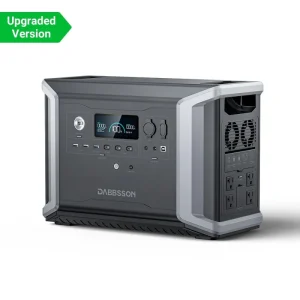Whereas a power station can be used in place of a backup generator for much of what is needed when it comes to short-term power or situations where being green and practical are concerned. Battery-based Power Stations have several advantages to traditional Gas powered generators in efficiency, low maintenance and enviromental kind such as Dabbsson DBS1000Pro. For instance the DBS1000Pro offers up to 1,000 watts of continuous power and 2,000 watts of surge power so you can use it to run critical household appliances like a fridge, lights or medical equipment when disaster strikes.
What is possibly the biggest benefit of using a power station as opposed to a gas generator state-of-art is that it operates completely emissions free. Obviously gas generators release a bunch of carbon monoxide and other fumes which make them inappropriate for indoor use. Power stations, on the other hand, run dead-silent and are emission-free which is essential for residential areas or when running them indoors. According to an Environmental Protection Agency report from 2022, almost 80% of generator deaths are because carbon monoxide exposure and the need for power stations as a much safer alternative.
Another point where power stations just beat the portable solar chargers is efficiency. Power stations only have to be recharged every once in a while, whereas gas generators need fuel and regular maintenance. A device such as the DBS1000Pro can be recharged from an AC outlet in 6-8 hours, or with solar panels — up to 8-12 hours under optimal conditions. To combat global warming and lower their energy bills, many homeowners now install power stations that can work with solar. A recent study in 2021 also reveals that Solar Power Stations can cut down on power bills by up to 30%, saving businesses and homes money into an emergency backup generator which have been the norm until today.

Power Stations Although power station are great for running small appliances and devices during a blackout, gas generators remain more powerful when it comes to high-power use. Using the basic power tool example, you can see even heavier (or less battery efficient?) machinery and a full household requires more watts than most portable power stations provide. Those are not at all that high as a whole-house generator can deliver as much as 5,000 to even up to 10,000-watts of power on average which is way way above what can be delivered by your ordinary standard portable power station. Yet for discriminating power use, including keeping basic units operating for in some cases hours or perhaps days, energy stations give a consistent fix.
And it would provide greater longevity for power station. For instance, the DBS1000Pro can be recharged up to 1,500 times before its capacity drops so low as to be useless. On the other hand, gas generators need maintenance with oil changes and fuel management which can be costly. The U.S. Department of Energy thinks that keeping a gas generator running costs about $150 per year, excluding fuel, power stations are nearly maintenance free.
Sustainable energy will be the future of power generation, spoken by Elon Musk. Power stations align with this vision, providing an environmentally friendly, cost-effective solution to backup generators.
Homeowners with critical energy needs looking for a dependable, hands-off ecology-friendly power source that can be used selectively (eg short-term outages), backup generators such as the DBS1000Pro are an appropriate long-term investment. Even if they cannot match the peak power output of massive generators, their safety, sustainability and ease of use make them an attractive option nowadays.